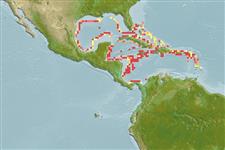>
Perciformes/Bembropoidei (Duckbill flatheads) >
Bembropidae (Duckbill flatheads)
Etymology: Bembrops: Greek, bembras, -ados = a kind of anchovy m+ Greek, ops = appearance (Ref. 45335); magnisquamis: Specific name from the Latin 'magnus' meaning large and 'squama' meaning scale..
More on author: Ginsburg.
Environment: milieu / climate zone / depth range / distribution range
Ekologi
laut batidemersal; kisaran kedalaman 350 - 465 m (Ref. 13203). Deep-water
Western Central Pacific: Caribbean Sea.
Size / Weight / umur
Maturity: Lm ? range ? - ? cm
Max length : 10.5 cm SL jantan/; (Ref. 13203)
deskripsi pendek
Morfologi | Morfometrik
Duri punggung (Keseluruhan (total)): 6; duri punggung lunak (Keseluruhan (total)): 15-16; Sirip dubur lunak: 17. Color in alcohol uniformly light yellowish brown. Snout relatively short, almost equal to eye diameter, with scales on lateral and dorsal surfaces including the area in front of eye. Upper jaw extending behind anterior margin of eye. Maxillary tentacle long, tapering at the end. Lateral line descending gradually in region of pectoral fin, separated from origin of first dorsal fin by 2-4 rows of scales, from origin of anal fin by 4-5, and from insertion of anal fin by 2. Spines of first dorsal fin not elongated (Ref 13203).
Life cycle and mating behavior
Kematangan | Reproduksi, perkembang biakan | Pemijahan | telur-telur | Fecundity | Larva
Das, M.K. and J.S. Nelson, 1996. Revision of the percophid genus Bembrops (Actinopterygii: Perciformes). Bull. Mar. Sci. 59(1):9-44. (Ref. 13203)
Status IUCN Red List (Ref. 130435)
ancaman kepada manusia
Harmless
penggunaan manusia
informasi lanjut
Nama-nama umumSinonim (persamaan)metabolismePemangsaEkotoksikologiReproduksi, perkembang biakanKematanganPemijahanSpawning aggregationFecunditytelur-telurpekembangan telor
Umur / SaizPertumbuhanpanjang-beratpanjang-panjangukuran frekuensiMorfometrikMorfologiLarvaDinamika larvapemulihanKelimpahanBRUVS
AcuanBudidaya airprofil budidaya airStrainGenetikaElectrophoresesDiturunkanPenyakit-penyakitPengolahanNutrientsMass conversion
mitraGambarStamps, Coins Misc.Suara-suaraCiguateraKecepatanTipe renangArea insangOtolithsOtakPenglihatan / visi
Alat, peralatan
laporan khas
muat turun XML
Sumber internet
Estimates based on models
Preferred temperature (Ref.
123201): 10.2 - 13.8, mean 12.2 °C (based on 8 cells).
Phylogenetic diversity index (Ref.
82804): PD
50 = 0.5000 [Uniqueness, from 0.5 = low to 2.0 = high].
Bayesian length-weight: a=0.00372 (0.00153 - 0.00904), b=3.10 (2.89 - 3.31), in cm total length, based on LWR estimates for this (Sub)family-body shape (Ref.
93245).
Trophic level (Ref.
69278): 3.8 ±0.4 se; based on size and trophs of closest relatives
Fishing Vulnerability (Ref.
59153): Low vulnerability (10 of 100).
